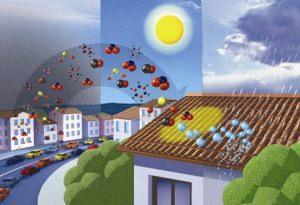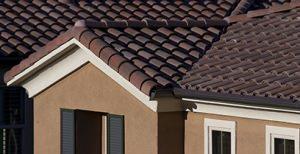Tiles anti-smog
Post from EditorialsIf you are about to renew your houses, the tiles anti-smog are a great contribution to the reduction of pollutants in the air.
The roof and the smog problem
The roof represents one of the horizontal closures of buildings.
Besides having a structural function, its task is to isolate and repair the internal structure from the elements, ensuring their water proofing and protection from wind, cold and heat. These functions are undertaken by the elements of which the roof is madre of which, depending on its conformation, is composed by several layers.
These functions are undertaken by the elements of which the roof is madre of which, depending on its conformation, is composed by several layers.
Essentially a roof consists of load-bearing elements, such as beams or trusses, from coats and insulating membranes, vapor barriers and roofing tiles.
Precisely the latter are available in the market with different features and specifications: the tile, the tile Marseillaise, the Portuguese tile, one Canadian, etc.
The choice in using one rather than another is dictated not only by purely aesthetic reasons, but also by the climatic conditions of the place: according to the rain level or snowfall the roof would be much or less sloped with pitched roof and rely on more performing roof tiles, that facilitate the water flow.
Together with these standard features, the tiles can perform others, not strictly related to the protection of the building structure, but sometimes to the environment.
There are in fact tiles called anti-smog, because they reduce the proportion of pollutants in the air.
Let's see what it is and how it works.
Anti-smog tiles
 The problem of air pollution affects our cities since long ago and in recent years the sensitivity to environmental issues is increased so as to make us, at least on paper, all ecologists.
The problem of air pollution affects our cities since long ago and in recent years the sensitivity to environmental issues is increased so as to make us, at least on paper, all ecologists.
It is not uncommon to hear reports of pollution of residential areas and consequent measures to be taken, such as number plate, blocking traffic, etc ..
And this is how, in a discussion related to an eco-sustainable behavior, fit the tiles so-called anti-smog, because they contribute to the reduction of dust in the environment.
Operation of anti-smog tiles
 The trees, by means of the photosynthesis convert carbon dioxide releasing oxygen, vital for man.
The trees, by means of the photosynthesis convert carbon dioxide releasing oxygen, vital for man.
Similarly, the surface of these special tiles transforms harmful nitrogen oxides, the major components of air pollution into common inorganic salts.
The composition of the tile is the same as the classical concrete, namely sand, cement and iron oxides, but the surface layer is composed of a high strength concrete with the addition of a catalytic agent, the TiO 2, titanium dioxide, a colorless to white crystalline powder, commonly used as a component in products of plastics, textiles and cosmetics.
Photocatalysis is a natural phenomenon for which a substance, the photocatalyst, if irradiated with adequate luminous intensity, accelerates the chemical reaction of oxidation of organic and inorganic substances. Since photocatalysis requires light to be fulfilled, in case of bad weather, the activity is reduced; it is important to emphasize that the rain is inserted positively in the process because it dissolves the inorganic salts produced by photocatalysis.
Since photocatalysis requires light to be fulfilled, in case of bad weather, the activity is reduced; it is important to emphasize that the rain is inserted positively in the process because it dissolves the inorganic salts produced by photocatalysis.
To date, unfortunately, are not so many Italian companies that produce the anti-smog tiles.
Among which are the company from Bolzano, Monier Wierer realizing building elements for roofs.
In this area Auranox® produces a tile guaranteed for 30 years, with very high levels of performance and certified by laboratory tests. The table shows how the contaminant NOx, inevitable product of every combustion process, is introduced inside the chamber ensuring a constant flow over time.
The ignition of a light source of adequate intensity allows the activation of Auranox®.
The analyzes carried out show that it is possible to realize a reduction of contaminants in 40 minutes.
The photocatalytic activity of the TiO2 continues throughout the time of life of the tile without altering the normal structure.
This allows to eliminate, in the case of a coverage of about 200 square meters, a quantity of pollutants equal to the emissions of a car of average cubic capacity for a year or those of 2 boilers used for heating of a residential property.
It is also a recyclable material because it consists of natural materials, waterproof, resistant to thaw and to the breaking load in bending, such as the common tiles.
Another example is provided by the American company Boral that, for the line Smog Eating Tile, produces Boral Pure, whose operation is identical to that described above. Probably these systems are adopted sporadically, they do not contribute significantly to improving the quality of the air we breathe.
Probably these systems are adopted sporadically, they do not contribute significantly to improving the quality of the air we breathe.
And yet, if under the renovation of a roof or of a new construction, there was a commitment by all to apply the new achievements of the most innovative technologies, aimed at respect for the environment, the positive results would soon arrive!
80838 REGISTERED USERS










